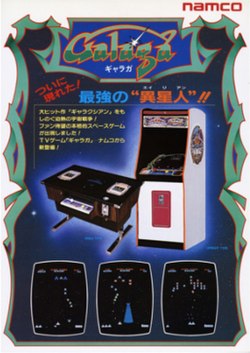Galaga
| Galaga | |
|---|---|

North American arcade flyer
|
|
| Developer(s) | Namco |
| Publisher(s) | |
| Composer(s) | Nobuyuki Ohnogi |
| Platform(s) | Arcade, Various |
| Release date(s) | |
| Genre(s) | Fixed shooter |
| Mode(s) | Single-player, multiplayer |
| Cabinet | Upright, cabaret, and cocktail |
| Arcade system | Namco Galaga |
| CPU | 3x ZiLOG Z80 @ 3.072 MHz |
| Sound | 1 × Namco WSG (3-channel mono) @ 3.072 MHz 1 × Namco 54xx @ 1.536 MHz |
| Display | RGB raster, vertical orientation (19-inch diagonal) |
Galaga (ギャラガ Gyaraga?) is a Japanese shoot 'em up arcade game developed and published by Namco Japan and by Midway in North America in 1981. It is the sequel to 1979's Galaxian. The gameplay of Galaga puts the player in control of a spacecraft which is situated at the bottom of the screen, with enemy aliens arriving in formation at the beginning of a stage, either trying to destroy, collide, or capture the spaceship, with the player progressing every time alien forces are vanquished.
Galaga is one of the most commercially and critically successful games from the golden age of arcade video games. The arcade version of it has been ported to many consoles, and it has had several sequels. In 2011, the game celebrated its 30th anniversary with the release of Galaga 30th Collection for iOS.
The objective of Galaga is to score as many points as possible by destroying insect-like enemies. The player controls a starfighter that can move left and right along the bottom of the playfield. Enemies swarm in groups in a formation near the top of the screen, and then begin flying down toward the player, firing bullets at and attempting to crash into them. In later stages, some enemies even break from an entering group in a frantic attempt to crash into the player. The game ends when the player's last fighter is lost by colliding with an enemy, being hit by an enemy shot, or being captured.
Galaga introduces new features from its predecessor, Galaxian. Among these are the ability to fire two shots in succession rather than one, a "hit/miss ratio" statistic at the end of the game, and a bonus "Challenging Stage" that occurs every few stages, in which a series of enemies fly onto and off the screen in set patterns without firing at the player's ship or trying to crash into it. When you destroy a group of enemies, you are awarded 1500 points. These stages award a 10K-point bonus if the player manages to destroy every enemy, but otherwise 100 bonus points for every enemy destroyed.
...
Wikipedia
